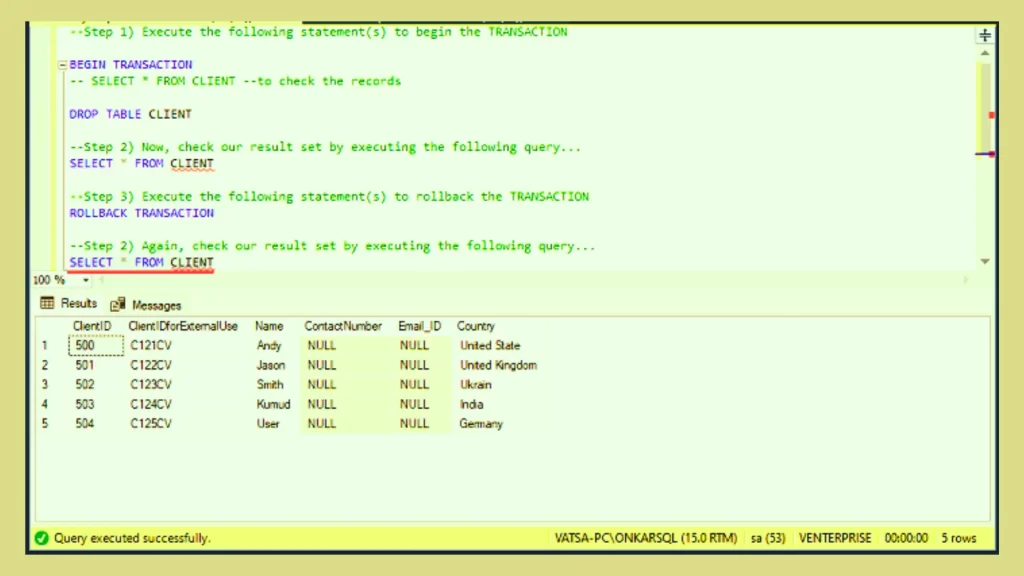When navigating the digital landscape or engaging in conversations about databases, software, and even real-life scenarios, you might encounter two terms that appear similar but hold distinct meanings: Delete and Drop.” While they both involve the removal of something, they are used in different contexts and come with unique implications. We’ll delve into the nuanced Difference between Delete and Drop, shedding light on their significance and when to apply each action.
Are you familiar with the difference between Drop and Delete?
Delete and Drop commands are SQL statements and are used to remove data from a SQL database. The DML command Delete deletes data from a database. The user can specify whether to delete all or some data in a particular table. The Delete statement only removes the records from the table.
The structure of the table remains the same. Drop is a DDL statement (Data Definition Language), and behaves differently than the Delete command. This is not a conditional statement and deletes all data in the table. It also removes table structure, as well as any references to the table from the database. We now know the details and differences between Delete and drop.
Definition of Delete and Drop
Delete: Delete is a term widely used in the context of removing data, files, or items from a system, database, or platform. When you delete something, you are intentionally discarding it, often with the option to recover or restore it later from a designated recycle bin or trash folder. The action of deleting preserves the possibility of retrieval, making it a suitable choice when you want to eliminate clutter without completely erasing the option for future retrieval.

Drop: Drop is a more specialized term, primarily used in the realm of databases. When you “Drop” a database object, such as a table or an index, you are permanently deleting it from the database schema. Unlike “Delete,” the “Drop” action doesn’t provide an easy recovery option. Once you drop a database object, it’s gone, and you would need to recreate it from scratch if needed.

Use the Delete Command
The Where clause can be used to specify the required condition. All table data will be removed if the Where clause does not appear with the Delete statement. The table structure is not altered by the Delete command. The user doesn’t need to specify the table structure to reuse it again. As it is a DML operation, Delete does not automatically commit after its execution.
This can then be undone to reverse the last operation. If you want to permanently make changes, then the Commit command should be used. The Delete statement records each row deleted in the Transaction Log. This slows down the process. It also does not deallocate space after the execution.
The syntax of the Delete statement is shown below.
DELETE FROM <table_name>
or
DELETE FROM <table_name> WHERE <condition>
How to Use Drop Statement
The Drop statement permanently removes all table records, as well as the integrity constraints, indexes, and privileges for the relevant table. All the tables’ relationships are also removed, as is the information regarding the table. If the user wishes to reuse the same table, they will need to define its structure as well as all references. Drop is a DDL command. Once the Drop command has been executed, the Drop command cannot be undone.

The user must be careful when using this command. The Drop command cannot be used on system tables or tables with foreign key constraints. The Drop command is not limited to SQL tables. It can also be used for database views and column columns. All data in these objects will disappear forever with them.
The syntax of the Drop command is shown below.
DROP TABLE <table_name>
What’s the difference between Drop and Delete?
- The Delete/Drop commands are used to remove data from tables in a database.
- The Delete command performs conditional deletions, while the Drop command removes all records from the table.
- The Drop command, on the other hand, removes both the entire table data and its structure as well as all references to the table from the database.
- Delete is DML, while Drop is DDL. The Delete operation is reversible and not auto-committed. However, Drop is not reversible as it’s an auto-committed operation.
- Drop cannot be applied to tables that are referenced with foreign keys. Instead, the Delete option can be selected.
- The Drop command is more complex than the SQL Delete statement and should only be used with care.
The key difference between DELETE and DROP in SQL below is given
- DELETE is used to delete some or all of the rows from a table. The DROP commands are used for removing schemas, tables, domains, or constraints from a database.
- DELETE, on the other hand, is a Data Manipulation Language Command.
- The DELETE command can be combined with a WHERE clause, but DROP cannot.
- The DELETE command allows you to roll back your actions, whereas the DROP command does not.
- DELETE does not remove the table, so no memory is released. However, the DROP command deletes all of the data and releases the space.
Comparison table between Drop and Delete
| Feature | DROP | DELETE |
| Basic Definition | Removes an entire table, view, index, or database from the database. | Removes rows from a table based on a condition. |
| Scope of Operation | Affects the entire structure. | Affects only data, not the structure. |
| Reversibility | Irreversible: once dropped, the structure is permanently removed. | Potentially reversible: if transactions are used, changes can be rolled back. |
| Where Clause | Not applicable. | Optional: allows specification of conditions to select rows to delete. |
| Effect on Table Structure | Removes the table or database structure entirely. | Leaves the structure intact; only removes data. |
| Effect on Indexes and Constraints | Removes related indexes and constraints. | Does not affect indexes and constraints directly. |
| Use in Transactions | Cannot be rolled back if executed within a transaction. | Can be rolled back within a transaction. |
| Impact on System Resources | Typically less resource-intensive as it is a single operation. | Can be resource-intensive, especially if deleting many rows. |
| Triggers | Does not activate triggers. | Can activate triggers based on row deletion. |
| Effect on Auto Increment Counters | Resets any auto-increment counters as the table is removed. | Does not reset auto-increment counters. |
| Common Usage | Used when an entire table or database is no longer needed. | Used to remove specific data while maintaining the table structure for future use. |
Exploring Use Cases
Understanding the appropriate scenarios for using “Delete” and “Drop” can prevent confusion and potential data loss. Let’s delve into some common use cases for both actions:
Delete Use Cases
- File Management: When you want to declutter your computer or storage device, you can delete files or folders you no longer need.
- Emails: Deleting emails from your inbox helps organize your communication history while keeping the option to retrieve them if necessary.
- Content Management Systems (CMS): In CMS platforms, you can delete articles, images, or pages that are outdated or irrelevant.
Drop Use Cases
- Database Optimization: Dropping unused tables, indexes, or columns can improve database performance by reducing unnecessary storage and query overhead.
- Schema Changes: When restructuring a database schema, you might drop existing tables before creating new ones to accommodate changes.
- Data Purge: In situations where data is no longer relevant or compliant with regulations, dropping the data ensures its complete removal.
The article will close with a closing paragraph
DELETE is a Data Manipulation Language command, a DML command. It is used for deleting rows within a table. ELETE, a Data Manipulation Language (DML) command, is used to delete tuples/records in a table/relation. DROP, on the other hand, is a Data Definition Language (DDL) command that is used to delete named schema elements such as relations/tables, constraints, or even an entire schema.


